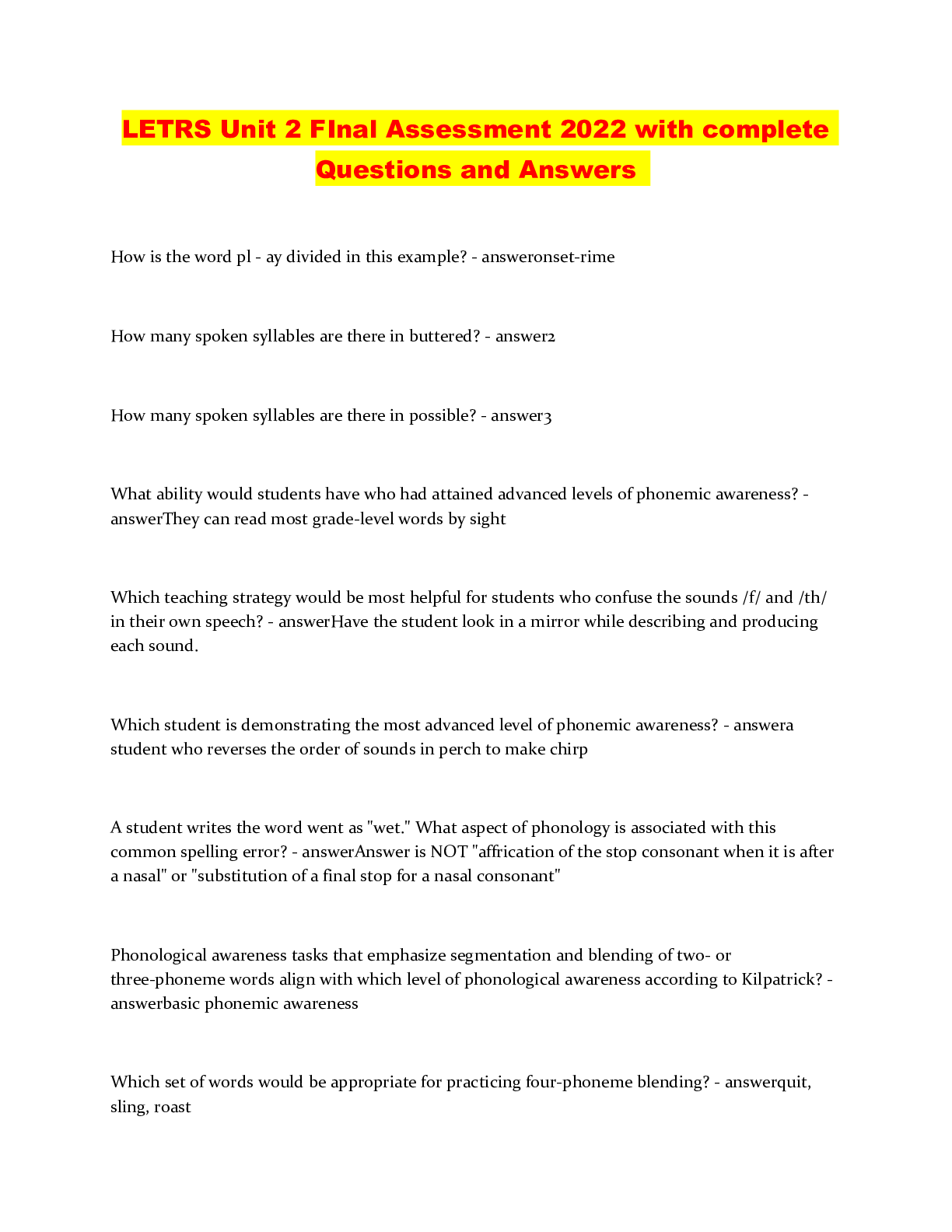Financial Accounting > QUESTIONS & ANSWERS > ACCOUNTING/ACTG MISC Valix Chapter 1- Chapter 6-joy. Over 200 Q&A. 100% Score. (All)
ACCOUNTING/ACTG MISC Valix Chapter 1- Chapter 6-joy. Over 200 Q&A. 100% Score.
Document Content and Description Below
Chapter 1 1. A complete set of financial statements includes all of the following components, except a. Statement of financial position, statement of comprehensive income and statement of cash f... lows. b. Statement of changes in equity c. Notes, comprising a summary of significant accounting policies and other explanatory information d. Reports and statements such as environmental reports and value added statements. 2. What is objective of financial statements ? a. To provide information about the financial position, financial performance and changes in financial position of an entity that is useful to a wide range of users in making economic decisions. b. To prepare a statement of financial position, statement of comprehensive income, statement of cash flows and statements of changes in equity. c. To present relevant, reliable, comparable and understandable information. d. To prepare financial statements in accordance with all applicable standards. 3. To meet the objective of providing information about financial position, financial performance and cash flows, financial statements should provide all, except a. Assets, liabilities and equity b. Income and expenses, including gains and losses c. Contributions by and distribution to owners d. Nature of business activities 4. The primary responsibility for the preparation and presentation of the financial statements of an entity is reposed in the a. Management of the entity b. Internal auditor c. External auditor d. Controller 5. When an entity changed the reporting period longer or shorter than one year, an entity shall disclose all of the following, except a. Period covered by the financial statements b. The reason for using a longer or shorter period c. The fact that amounts presented in the financial statements are not entirely comparable d. The fact that similar entities in the geographical area in which the entity operates have done so. 6. Which of the following is not a component of the financial statements? a. Statement of financial position b. Statement of changes in equity c. Report of board of directors d. Notes to financial statements 7. Which of the following is included in a complete set of financial statements? a. A statement by the board of directors of compliance with local legislation b. A statement of changes in equity c. Statements of financial position for the last five years d. Value added statement 8. Which of the following is included within the financial statements? a. A statement of retained earnings b. Accounting policies c. An auditor’s report d. A director’s report 9. An entity shall clearly identify each financial statement and display all of the following, except a. Name of the reporting entity b. Name of major shareholders of the entity c. The presentation currency d. Whether the financial statements cover the individual entity or a group of entities 10. Which of the following statements is incorrect concerning fair presentation of financial statements? a. Fair presentation requires the faithful representation of the effect of transactions and other events b. Financial statements shall present fairly the financial position, financial performance and cash flows of an entity c. In virtually all circumstances, a fair presentation is achieved by compliance with applicable PFRS d. An entity whose financial statements comply with PFRS shall not make an explicit and unreserved statement of such compliance in notes 11. Which of the following cannot be considered fair presentation of financial statements? a. To present information in a manner that provides relevant and faithfully represented financial information b. To provide additional disclosures when compliance with specific PFRS is insufficient to understand the financial position and financial performance c. To select and apply accounting policies in accordance with applicable PFRS d. To rectify inappropriate accounting policies either by disclosure of the accounting policies used or by notes or explanatory information 12. Which of the following statements indicates a going concern? a. Management intends to liquidate the entity b. Management intends to cease the operations of the entity c. Management has no realistic alternative but to cease the operations of the entity d. None of these 13. An entity is permitted to depart from a particular standard if all of the following conditions are satisfied, except a. In extremely rare circumstances b. When management concludes that compliance with the standard would be misleading c. When the departure from the standard is necessary to achieve fair presentation d. When the Conceptual Framework for Financial Reporting prohibits such a departure 14. The effects of transactions and other events on economic resources and claims are depicted in the periods in which those effects occur even if the resulting cash receipts and payments occur in a different period a. Accrual accounting b. Cash accounting c. Modified accrual accounting d. Modified cash accounting 15. Financial statements must be prepared at least a. Annually b. Quarterly c. Semiannually d. Every two years 16. Technically, offsetting in financial statements is accomplished when a. The allowance for doubtful accounts is deducted from accounts receivable b. The accumulated depreciation is deducted from property, plant and equipment c. The total liabilities are deducted from total assets to arrive at net assets d. Gain or loss from disposal of noncurrent asset is reported by deducting from the proceeds the carrying amount of the asset and the related disposal cost 17. The presentation and classification of items in the financial statements shall be retained from one accounting period to the next a. Consistency f presentation b. Materiality c. Aggregation d. Comparability 18. A third statement of financial position as at beginning of the earliest comparative period presented is required I. When an entity applies an accounting policy retrospectively II. When an entity makes a retrospective restatement of items in the financial statements III. When an entity reclassifies items in the financial statements a. I and II only b. I and III only c. II and III only d. I, II and III 19. An entity shall prepare how many statements of financial position as a result of retrospective application, retrospective restatement and reclassification of items in the financial statements? a. Two b. Three c. Four d. One 20. Items of dissimilar nature or function a. Must always be presented separately b. Must not be presented separately c. Must be presented separately in financial statements if those items are material d. Must be presented separately in financial statements even if those items are immaterial 21. An entity must disclose comparative information for a. The previous comparable period for all amounts reported b. The previous comparable period for all amounts reported and for all narrative and descriptive information c. The previous comparable period for all amount reported, and for all narrative and descriptive information when it is relevant to an understanding of the current period’s financial statements d. The previous two comparable periods for all amounts reported 22. When the classification of items in the financial statements is changed, the entity a. Must not reclassify the comparative amounts b. Can choose whether to reclassify the comparative amounts c. Must reclassify the comparative amounts unless it is impracticable to do so d. Must reclassify the current year amounts only 23. An entity shall present a. The statement of cash flows more prominently thatn the other statements b. The statement of financial position more prominently than the other statements c. The statement of comprehensive income more prominently than the other statements d. Each financial statement with equal prominence 24. What is obhective of financial reporting under the Conceptual Framework for Financial Reporting? a. To provide information about the financial position, performance and cash flows of an entity b. To prepare and present a statement of financial position and a statement of comprehensive income c. To provide financial information about an entity that is useful to existing and potential investors, lenders providing resources to the entity d. To prepare financial statements in accordance with all applicable standards and interpretations 25. The primary focus of financial reporting has been on meeting the needs of which of the following? a. Managers of an entity b. Existing and potential investors, lender and other creditors c. National and local taxing authorities d. Independent CPAs 26. Which of the following statements best describes the term “financial position”? a. The net income and expenses of an entity b. The net of financial assets less liabilities of an entity c. The potential to contribute to the flow of cash and cash equivalents to the entity d. The assets, liabilities and equity of an entity 27. Which of the following best describes the term :financial performance”? a. The revenue, expenses and net income or loss for a period of an entity b. The assets, liabilities and equity of an entity c. The total assets minus total liabilities d. The total cash inflows minus total cash outflows 28. The overall objective of financial reporting is to provide information a. That is useful for decision making b. About assets, liabilities and equity c. About financial performance during a period d. That allows owners to assess performance of management 29. Which is an objective of financial reporting? a. To provide information that is useful in making investing and credit decision b. To provide information that is useful to management c. To provide information to those investing in the entity d. To provide information about ways to solve internal and external conflicts about the entity 30. An objective of financial reporting is to provide a. Information about the investors in the entity b. Information about the liquidation value of the resources of the entity c. Information that is useful in assessing cash flow prospects d. Information that will attract new investors 31. As part of the objective of financial reporting, the phrase “assessing cash flow prospects” is interpreted to mean a. Cash basis accounting is preferred over accrual basis accounting b. Information about the financial effects of cash receipts and cash payments is generally considered the best indicator of an entity’s present and continuing ability to generate favorable cash flows c. Over the long run, trends in revenue and expenses are generally more meaningful than trends in cash receipts and disbursement d. All of the choices are correct regarding “assessing cash flow prospects”. 32. The objective of financial reporting is based on a. The need for conservatism b. Reporting on management’s stewardship c. Generally accepted accounting principles d. The needs of the users of the information 33. During a period when an entity is under the direction of a particular management, financial reporting will directly provide information about a. Both entity performance and management performance b. Management performance but not management performance c. Entity performance but not management performance d. Neither entity performance nor management performance 34. Financial reporting pertains to a. Individual business entities, rather than to industries or an economy as a whole or to members of society as consumers b. Individual business entities and an economy as a whole or to members of society as consumers c. Individual business entities and an economy as a whole, rather than to industries or to members of society as consumers d. Individual business entities, industries and an economy as a whole, rather than to members of society as consumers 35. Which of the following is not an objective of financial reporting? a. Financial reporting shall provide information about resources, claims against those resources and changes in them b. Financial reporting shall provide information useful in evaluating stewardship of management c. Financial reporting shall provide information useful in investment, credit and similar decision d. Financial reporting shall provide information useful in assessing cash flow prospects 36. Which of the following is not an objective of financial reporting? a. To provide information about assets and claims against those assets b. To provide information that is useful in assessing sources and uses of cash c. To provide information that is useful in lending and investing decisions 37. Which would likely prepare the most accurate financial forecast for an entity based on empirical evidence? a. Investors using statistical models b. Corporate management c. Financial analysts d. Independent certified public accountants 38. The most useful information in predicting future cash flows is a. Information about current cash flows b. Current earnings based on accrual accounting c. Information regarding the accounting policies used d. Information regarding the results obtained by using a wide variety of accounting policies 39. The accrual basis of accounting is most useful for a. Determining the amount of income tax liability b. Predicting short-term financial performance c. Predicting long-term financial performance d. Determining the amount of dividends to shareholders 40. The financial statements prepared under GAAP a. Do not articulate with one another b. Reflect a single measurement which is historical cost c. Are not highly precise because estimate and judgment must be made d. Contain a limited number of future projections 41. In measuring financial performance, accrual accounting is used because a. Cash flows are considered less important b. It provides a better indication of ability to generate cash flows than cash basis c. It recognizes revenue when cash is received and expense when cash is paid d. It is one of the implicit assumptions Chapter 2 1. The components financial statements include all of the following, except a. Statement of financial position b. Income statement c. Statement of cash flows d. Statement of retained earnings 2. The major financial statements include all, except a. Statement of financial position b. Statement of changes in financial position c. Statement of comprehensive income d. Statement of changes in equity 3. Which following represents a form of communication through financial reporting but not through financial statements? a. Statement of financial position b. President’s letter c. Income statement d. Notes to financial statements 4. The satatement of financial position is useful for analyzing all of the following, except a. Liquidity b. Solvency c. Profitability d. Financial flexibility 5. The amount of time that is expected to elapse until an asset is realized or otherwise converted into cash is referred to as a. Solvency b. Financial flexibility c. Liquidity d. Exchangeability 6. The statement of financial position provides a basis for all of the following, except a. Computing rate of return b. Evaluating capital structure c. Determining increase in cash due to operations d. Assessing liquidity and financial flexibility 7. The information reported in the statement of financial position is useful for all of the following, except a. To compute rate of return b. To analyze cash inflows and outflows for the period c. To evaluate capital structure d. To assess future cash flows 8. Which criticism is not normally aimed at the statement of financial position? a. Failure to reflect current value information b. The extensive use of separate information c. An extensive use of estimate d. Failure to include items of financial value 9. The statement of financial position a. Omits many items that are of financial value b. Makes very limited use of judgment and estimate c. Uses fair value for most assets and liabilities d. All of the choices are correct regarding the statement of financial position 10. Which of the following is a limitation of the statement of financial position? a. Many items that are of financial value are omitted b. Judgment and estimate are used c. Current fair value is not reported d. All of these are considered limitation of the statement of financial position. 11. In presenting a statement of financial position, an entity a. Must make the current and noncurrent presentation b. Must present assets and liabilities in order of liquidity c. Must choose either the current and noncurrent or the liquidity presentation d. Must make the current and noncurrent presentation except when a presentation based on liquidity provides information that is reliable and more relevant. 12. Current and noncurrent presentation of assets and liabilities provides useful information when the entity a. Supplies good or services within a clearly identifiable operating cycle b. Is a financial institution c. Is a public utility d. Is a nonprofit organization 13. A presentation of assets and liabilities in increasing or decreasing order of liquidity provides information that is faithfully represented and more relevant for a. Financial institution b. Public utility c. Government-owned entity d. Service provider 14. Which of the following statements in relation to financial statements is incorrect? a. General purpose financial statements do not and cannot provide all of the information that primary users need b. General purpose financial statements are designed to show the value of the reporting entity c. General purpose financial statements are intended to provide common information to users d. Financial statements are largely based on estimate and judgment rather than exact depiction 15. Which obligations are classified as current even if the obligations are due to be settled after more than twelve months from the end of reporting period? a. Trade payables b. Current portion of noncurrent financial liabilities c. Bank overdrafts d. Dividends payable 16. In the Philippines, the common practice is to present in the statement of financial position a. Current assets before noncurrent assets, current liabilities before noncurrent liabilities and equity after liabilities b. Noncurrent assets before current assets, noncurrent liabilities before current liabilities and equity after liabilities c. Current assets before noncurrent assets, noncurrent liabilities before current liabilities and equity after liabilities d. Noncurrent assets before current assets, current liabilities before noncurrent liabilities and equity after liabilities 17. An entity shall classify an asset as current under all of the following conditions, except a. The entity exact to realize the asset or intends to sell or consume the asset within the entity’s normal operating cycle b. The entity holds the asset for the purpose of trading c. The entity expects to realize the asset within twelve months after the reporting period d. The asset is cash or a cash equivalent that is restricted to settle a liability for more than twelve months after the report period 18. An entity shall classify a liability as current under all of the following conditions, except a. The entity expects to settle the liability within the entity’s normal operating cycle b. The entity holds the liability primarily for the purpose of trading c. The liability is due to be settled within twelve months after the reporting period d. The entity has an unconditional right to defer settlement of the liability for at least twelve months after the reporting period 19. A financial liability that is due to be settled within twelve months after the reporting period shall be classified as noncurrent a. When it is refinanced on a long-term basis before the issue of financial statements b. When the entity has no discretion to refinance for at least twelve months c. When it is refinanced on a long-term basis after the end of reporting period d. When it is refinanced on a long-term basis on or before the end of reporting period. 20. When an entity breaches under a ong-term loan agreement on or before the end of the reporting period with the effect that the liability becomes payable on demand, the liability becomes payable on demand, the liability is classified as a. Current under all circumstances b. Noncurrent under all circumstances c. Current if the lender has agreed after the reporting period and before the issuance of the statement not to demand payment as a consequences of the breach d. Noncurrent if the lender agreed after the end of the reporting period to provide a grace period for at least twelve months after the reporting period 21. A contingent liability a. Definitely exist as a liability but the amount and due date are indeterminable b. Is accrued even though not reasonably estimated c. Is the result of a loss contingency d. Is not recognized in the financial statements 22. Which of the following statements is incorrect concerning contingent liability? a. A contingent liability is not recognized In the financial statements b. A contingent liability is disclosed only c. If the contingent liability is remote, no disclosure is required d. A contingent liability is both probable and measurable 23. It is a possible asset that arises from past event and whose existence will be confirmed only by the occurrence or nonoccurrence of one or more uncertain future events not wholly within the control of the entity a. Contingent asset b. Other asset c. Suspense account d. Current asset 24. Which of the following statements is incorrect concerning a contingent asset? a. A contingent asset is not recognized in the financial statements because this may result to recognition of income that may never be realized b. When the realization of income is virtually certain, the related asset is no longer contingent asset and its recognition is appropriate c. A contingent asset is only disclosed when the occurrence of the future event is possible or remote d. The related gain arising from the contingent asset is recognized usually when it is realized 25. In which section of the statement of financial position should cash that is restricted for the settlement of a liability due 18 months after the reporting period be presented? a. Current assets b. Equity c. Noncurrent liabilities d. Noncurrent assets 26. Which one of the following is not required to be presented as minimum information on the face of the statement of financial position? a. Investment property b. Investment accounted for under the equity method c. Biological asset d. Contingent liability 27. Which of the following must be included in the statement of financial position? a. Contingent asset b. Property, plant and equipment analyzed by class c. Share capital and reserves analyzed by class d. Deferred tax 28. Which of the following must be included on the face of the statement of financial position? a. Investment property b. Number of shares authorized c. Contingent liability d. Shares in an entity owned by that entity 29. Which of the following statements in relation to the statement of financial position is true? I. Biological assets must be shown in the statement of financial position II. The number of shares authorized for issue may be shown in the statement of financial position or the statement of changes in equity or in the notes a. I only b. II only c. Both I and II d. Neither I nor II 30. Which is not in accordance with IFRS regarding the presentation of current liabilities? a. The noncurrent liabilities follow the current liabilities b. Current liabilities may be listed in order of maturity, in descending order of magnitude or in order of liquidity preference c. Current liabilities are generally recorded at full maturity value d. Current liabilities should not be offset against the assets used for liquidation 31. In which section of the statement of financial position should employment taxes due for settlement in 15 months’ time be presented? a. Current liabilities b. Current assets c. Noncurrent liabilities d. Noncurrent assets 32. An entity has a loan due for repayment in six months’ time, but the entity has the option to refinance for repayment two years later. The entity plans to refinance this loan. In which section of the statement of financial position should this loan be presented? a. Current liabilities b. Current assets c. Noncurrent liabilities d. Noncurrent assets 33. The short-term obligations of an entity at the end of reporting period include 90-day notes payable renewable for another 90-day period. The notes payable shall be classified in the statement of financial position as a. Current liabilities b. Deferred charges c. Noncurrent liabilities d. Intermediate debt 34. At the end of reporting period, an entity has a 120-day note payable outstanding. The entity has followed the policy of replacing the note rather than repaying it over the last three years. The entity’s treasurer says that this policy is expected to continue indefinitely and the arrangement is acceptable to the bank to which the note was issued. The proper classification of the note in the year-end statement of financial position is a. Dependent on the intention of management b. Dependent on the actual ability to refinance c. Current liability, unless specific refinancing criteria are net d. Noncurrent liability 35. In analyzing financial statements, which financial statement would a potential investor primarily use to assess liquidity and financial flexibility? a. Statement of retained earnings b. Income statement c. Statement of changes in equity d. Statement of financial position 36. Which of the following is an essential characteristic of an asset? a. The claims to an asset’s benefits are legally enforceable b. An asset is tangible c. An asset is obtained at a cost d. An asset provides future benefits 37. Working capital is a. The group of assets which enables the entity to operate profitability b. Total current assets c. Total current assets minus total current liabilities d. Capital invested in business 38. Conceptually, asset valuation accounts are a. Assets b. Neither assets nor liabilities c. Part of shareholder’s equity d. Liabilities 39. The term “net assets” represent a. Retained earnings b. Current assets less current liabilities c. Total paid in capital d. Total assets less total liabilities 40. When classifying assets as current and noncurrent for reporting purposes a. The amounts at which current assets are reported must reflect realizable cash value b. Prepayments are included in other assets c. Current assets are determined by the seasonal nature of the business d. Assets are classified as current if these are reasonably expected to be realized in cash or consumed during the normal operating cycle 41. The operating cycle concept a. Causes current and noncurrent items to depend on whether they will affect cash within one year b. Permits some asset to be classified as current even if more than one year removed from becoming cash c. Has become obsolete d. Affects the income statement 42. The basis for classifying assets as current or noncurrent is the period of time normally elapsed from the time the accounting entity expends cash to the time it converts a. Inventory back into cash or 12 months, whichever is shorter b. Receivables back into cash or 12 months, whichever is longer c. Tangible fixed assets back into cash, or 12 months, whichever is longer d. Inventory back into cash or 12 months, whichever is longer 43. Which of the following should be classified as current asset? a. Trade installment accounts receivable normally collectible in 18 months b. Preference share redemption fund c. Cash surrender value of a life insurance policy d. A deposit on machinery ordered, delivery of which will be made within six months 44. The essential characteristics of an asset include all, except a. The asset is the result of pass event b. The asset provides future economic benefit c. The cost of the asset can be measured reliably d. The asset is tangible 45. Which statement is incorrect regarding assets? a. An asset represents a probable future economic benefit b. An asset is obtained or controlled as a result of probable future event c. Assets reported in the statement of financial position include current and noncurrent assets d. Assets include costs that have not yet been matched with revenue 46. Equity investments held to finance future construction of additional plant should be classified as a. Current assets b. Property, plant and equipment c. Intangible assets d. Long-term investments 47. Which of the following is not a noncurrent investment? a. Cash surrender value of life insurance b. Franchise c. Land held for speculation d. A sinking fund 48. The term “deficit” to a. An excess of current assets over current liabilities b. An excess of current liabilities over current assets c. A debit balance in retained earnings d. A loss that is reported as a prior period error 49. The correct order to present current assets is a. Cash, inventories, prepaid items, account receivable b. Cash, inventories, account receivable, prepaid items c. Cash, accounts receivable, prepaid items, inventories d. Cash, account receivable, inventories, prepaid items 50. Which should be classified as a noncurrent asset? a. Plant expansion fund b. Prepaid rent c. Supplies d. Goods in process 51. Which of the following items would normally be excluded from the computation of working period a. Advance from customers b. The portion of long-term debt that matures within one year after the reporting period c. Prepaid insurance d. Cash surrender value of life insurance policy 52. Accrued revenue would normally appear in the statement of financial position under a. Noncurrent assets b. Current liabilities c. Noncurrent liabilities d. Current assets 53. An operating cycle a. Is twelve months or less in length b. Is the average time required for an entity to collect account receivable c. Is used to determine current assets when the operating cycle is longer than one year d. Starts with accounts receivable and ends with cash 54. For liability to exist a. There must be a past event b. The exact amount must be known c. The identity of the party to whom the liability is owed must be known d. There must be an obligation to pay cash in the future 55. Which of the following best describes the term “liability”? a. An excess of equity over current assets b. Resources to meet financial commitments when due c. The residual interest in the assets of the entity after deduction all of the liabilities d. A present obligation arising from past event 56. Which item is not a current liability? a. Unearned revenue b. Stock dividend payable c. The currently maturing portion of long-term debt d. Trade account payable 57. Noncurrent liabilities include a. Bonds payable b. Accrued benefit cost c. Deferred tax liability d. All of these are noncurrent liabilities 58. Which is not within the definition of a liability? a. The signing of a three-year employment contract at a fixed annual salary b. An obligation to provide goods or services in the future c. A note payable with no specified maturity date d. A present obligation that is estimated in amount Chapter 3 1. Which of the following is not a purpose of notes to financial statements? a. To present information about the basis of preparation of the financial statements and the specific accounting policies used b. To disclose the information required by Philippine Financial Reporting Standards that is not presented elsewhere in the financial statements c. To provide additional information which is not presented in the financial statements but that is necessary for a fair presentation d. To provide information about the financial position, financial performance and cash flows of an entity that is useful to wide range of users in making economic decisions 2. What is the proper order of presenting the notes to financial statements? I. Statement of compliance with PFRS II. Other disclosures, such as contingent liabilities, unrecognized contractual commitments and other nonfinancial disclosures III. Supporting information for items presented on the face of the financial statements IV. Summary of significant accounting policies a. I, II, III and IV b. I, IV, III and II c. I, III, IV and II d. I, IV, II and III 3. Which of the following statements is true concerning compliance with PFRS? I. An entity whose financial statements comply with Philippine Financial reporting Standards shall make an explicit and unreserved statement of such compliance in the notes. II. An entity shall not describe financial statements with PFRS unless they comply with all the requirements of each applicable Philippine Financial Reporting Standard. a. I only b. II only c. Both I and II d. Neither I and II 4. An entity is required to disclose certain non financial information. Which of the following is not embraced in this disclosure? a. A description of the nature of the entity’s operations and the principal activities b. The name of the parent entity and the ultimate parent of the group c. Domicile and legal of the entity, the country of incorporation and address of the registered office d. Names and addresses of the corporate directors and officers 5. Notes to the financial statements should not be to used to a. Describe significant accounting policies b. Describe depreciation method employed c. Describe the principles and methods peculiar to the industry in which the entity operates d. Correct an improper presentation in the financial statements 6. The cross-reference between each line item in the financial statements and any related information disclosed in the notes to the financial statements a. Is voluntary b. Is mandatory c. Depends on the industry d. Is either voluntary or mandatory 7. The presentation of the notes to the financial statements in a systematic manner a. Is voluntary b. Is mandatory c. Is mandatory, as far as practicable d. Depends on the industry 8. An entity shall disclose in the summary of significant accounting policies a. The measurement basis used b. All the measurement basis specified in IFRS c. The measurement basis and the accounting policies used in preparing the financial statements d. All the measurement basis and the accounting policy choices specified in IFRS 9. Disclosure of information about key sources of estimation uncertainty a. Is voluntary b. Is mandatory c. Is either voluntary or mandatory d. Depends on the industry 10. Disclosure of information about judgment a. Is voluntary b. Is mandatory c. Is either voluntary or mandatory d. Depends on the industry 11. Which of the following statements is incorrect regarding notes to the financial statements? a. IFRS requires specific note disclosures including disaggregation of inventories into classifications such as merchandise, production supplies, work in process and finished goods b. IFRS requires a maturity analysis for receivables c. IFRS requires that all notes should be clear, simple to understand and nontechnical in nature d. All of the choices are correct regarding notes to financial state 12. Notes to financial statements a. Must be quantifiable b. Must qualify as element c. Amplify or explain items presented in the financial statements d. All of the choices are correct regarding notes to financial statements 13. Which of the following is not a method of disclosing pertinent information? a. Supporting schedule b. Parenthetical explanation c. Cross reference and contra item d. All of these are methods of disclosing pertinent information 14. The disclosure of accounting policies is important to financial statement readers in determining a. Net income for the year b. Whether accounting policies are consistently applied from year to year c. The value of obsolete goods included in ending inventory d. Whether the working capital position is adequate for future operations 15. Accounting policies disclosed in the notes to financial statements typically include all of the following, except a. The cost flow assumption b. The depreciation method c. Significant estimates d. Significant inventory purchasing policies 16. Significant accounting policies may not be a. Selected on the basis of judgment b. Selected from existing acceptable alternatives c. Unusual or innovative in application d. Omitted from financial statement disclosure 17. Which of the following should be defined as intentional distortion of financial statement? a. Error b. Fraud c. Error and fraud d. Neither error nor fraud 18. An example of an inventory accounting policy that should be disclosed in a summary of significant account policies is a. Composition of inventory into raw materials, work in process and finished goods b. Major backlog of inventory orders c. Method used for pricing inventory d. All of these should be disclosed in the summary of significant accounting policies 19. The standard of adequate disclosure is best described by which of the following? a. All information related to the business of an entity and operating objective is required to be disclosed in the financial statements b. Information about each account balance appearing in the financial statements is to be included in the notes to financial statements c. Enough information should be disclosed in the financial statements so a person wishing to invest in the entity can make a wise decision d. Disclosure of any financial facts significant enough to influence the judgment of an informed user 20. Application of the standard of adequate disclosure a. Is theoretically desirable nut not practical because the cause of complete disclosure exceeds the benefit b. Is violated when important financial information is buried in the notes to financial statements c. Is demonstrated by the use of supplementary information presenting the effects of changing prices d. Requires that the financial statements should be consistent and comparable 21. What is the purpose of information presented in the notes to financial statements? a. To provide disclosures required by generally accepted accounting principles b. To correct improper presentation in the financial statements c. To provide recognition of amounts not included in the total of the financial statements d. To present management response to auditor comments 22. Which of the following information should be disclosed in the summary of significant accounting policies? a. Refinancing of debt subsequent to the reporting period b. Guarantee of indebtedness of other c. Criteria for determining which investments are treated as cash equivalents d. Adequacy of pension plan assets relative to the defined benefit obligation 23. Which of the following should be disclosed in a summary of significant accounting policies? a. Type of executor contract b. Amount for cumulative effect of change in accounting policy c. Claims of equity holders d. Depreciation method followed 24. Which of the following is not a required disclosure of accounting policies? a. The measurement basis used b. Key management personnel involved in drafting the summary of significant accounting policies c. Disclosures required by standards d. The nature of operations and the policies that the users of the financial statements would expect to be disclosed Chapter 4 1. A party is related to an entity if the party, directly or indirectly, through one or more intermediaries a. Controls, is controlled by or is under common control with the entity b. Has an interest in the entity that gives it significant influence over the entity c. Has joint control over the entity d. All of these define a related party 2. Related parties include all of the following, except a. Parent, subsidiary and fellow subsidiaries b. Associate c. Key management personnel and close family members d. Two venturers simply because they share joint control 3. A related party transaction is a transfer of resources or obligations a. Between related parties when a price is charged b. Between related parties, regardless of whether a price is charged c. Between unrelated parties when a price is charged d. Between unrelated parties, regardless of whether a price is charged 4. Unrelated parties include which of the following? a. Providers of finance in the course of their normal dealings with an entity by virtue only of these dealings b. Government agencies c. Single customer with whom an entity transacts a significant volume of business merely by virtue of the resulting economic dependence d. All of these are unrelated parties 5. This is pricing policy between related parties which sets the price by reference to comparable goods sold in an economically comparable market to a buyer unrelated to the seller a. No price method b. Cost plus method c. Resale price method d. Uncontrolled price method 6. Close family members if of an individual include all of the following, except a. the individual’s spouse and children b. children of the individual’s spouse c. dependents of the individual or individual’s spouse d. brothers and sisters of the individual 7. the minimum disclosures about related party transactions include all of the following, except a. the amount of the transaction b. amount of outstanding balance c. allowance for doubtful accounts related to the outstanding balance d. nature of the relationship 8. an entity that entered into certain related party transactions would be required to disclose all of the following information, except a. nature of the relationship between the parties to the transactions b. nature of any future transactions planned between the parties and the terms involved c. peso amount of the transactions d. amount due from or to related parties at the end of reporting period 9. which would not be considered key management personnel compensation? a. Short-term benefits b. Share-based payments c. Termination benefits d. Reimbursement of out-of-pocket expenses 10. Which of the following is not a mandated disclosure about related party transactions? a. Relationship between parent and subsidiaries irrespective of whether there have been transactions between the related parties b. Names of all the associates that an entity has dealt with during the year c. Name of the entity’s parent and, if different, the ultimate controlling party d. If neither the entity’s parent nor the ultimate controlling entity produces financial statements available for public use, then the name of the next most senior parent that does so 11. Which of the following is not a required minimum disclosure about related party transaction? a. The amount of related party transaction b. The amount of the outstanding balance c. The amount of similar transaction with unrelated parties to establish that comparable related party transaction has been entered at arm’s strength d. Doubtful debt related to the outstanding balance 12. Which of the following is not required as a separate related party disclosure? a. The son of the chief executive officer of the entity b. The parent of the entity c. An entity that has a common director with the entity d. Joint venture in which the entity is a venturer 13. All of the following are related parties, except a. Joint venture in which the entity is a venturer b. A postemployment benefit plan for the employees c. An executive director of the entity d. The partner of a key manager is a major supplier of the entity 14. Which of the following should be included in key management personnel compensation? a. Social security contributions b. Postemployment benefits c. Social security contribution and postemployment benefits d. Social security contributions, postemployment benefits and dividends to shareholders 15. Which of the following is not a related party of an entity? a. A shareholder of the entity owning twenty percent b. An entity providing banking facilities to the entity c. An associate of the entity d. Key management personnel of the entity 16. All of the following are related party transactions, except a. Transferred goods from inventory to a subsidiary b. Sold an entity car to the wife of the managing director c. Sold an asset to an associate d. Took out a huge bank loan 17. Disclosures of related party transactions include all, except a. Nonmonetary exchange by affiliates b. Sales of inventory by a subsidiary to the parent c. Expense allowances for executives which exceed normal business practice d. An entity’s agreement to act as surety for a loan to the chief executive officer 18. Related party transactions include all of the following, except a. A venturer sold goods to the joint venture b. Sold a car to the uncle of the entity’s finance director c. Sold goods to another entity owned by the daughter of the entity’s managing director d. All of these are related party transactions 19. Which of the following most likely would be a related party transaction requiring disclosure? a. The entity borrowed P1,000,000 from the southwest bank issuing a noninterest-bearing note b. The entity borrowed P500,000 from Eastwest bank with no scheduled term for how or when fund will be prepaid c. The entity borrowed P2,000,000 from northwest bank at a rate significantly above the prevailing market rate d. All of these are related party transactions 20. A parent entity has a wholly-owned subsidiary. During the current year, the parent sold goods to the subsidiary. The subsidiary paid a party of the debt before the year-end and then encountered financial difficulties. The subsidiary is not expected to be able to pay the remainder of the balances and therefore it has been provide as uncollectible. Administration cost are incurred as a result of the current credit controllers chasing the debt. All of the following are required to be disclosed in relation to this arrangement, except a. The administration cost of the credit control department incurred in chasing the debt b. Details of any guarantee received in relation to the outstanding balance c. The provision in relation to the debt being uncollectible d. The amount of the transaction and outstanding balance Chapter 5 1. Financial statements are authorized for issue a. When the board of directors reviews and authorized the financial statements for issue b. When the shareholders approve the financial statements at their annual meeting c. When the financial statements are filed with the regulatory agency d. When a supervisory board made solely of nonexecutives approves the financial statements 2. Adjusting events after the reporting period include all of the following, except a. The settlement of a court case after the issuance of the financial statements that confirms that the entity had already a present obligation b. Bankruptcy of a customer which occurs after the end of reporting period but before issuance of financial statements c. Discovery of errors that show that the financial statements were incorrect d. Determination after the end of reporting period and before issuance of financial statements of the cost of asset purchased before end of reporting period 3. Which of the following events after the reporting period would require adjustment? a. Loss of plant as a result of fire b. Change in the market price of investment c. Loss on inventory resulting from flood loss d. Loss on a lawsuit the outcome of which was deemed uncertain at year-end 4. Which of the following events after the end of reporting period would generally require disclosure? a. Retirement of key management personnel b. Settlement of litigation when the event that gave rise to the litigation occurred in a prior period c. Strike of employees d. Issue of a large amount of ordinary shares 5. Events after the reporting period are favorable or unfavorable events that occur between a. The end of the reporting period and the date of the next annual financial statements b. The end of the reporting period and the date of the next interim or annual financial statements c. The end of the reporting period and the date when the financial statements are authorized for issue d. The end of reporting period and the date of the next interim statements 6. Adjusting events are those that a. Provide evidence of condition that exited at the end of the reporting period b. Are indicative of conditions that arose after the end of the reporting period c. Are indicative of conditions that arose after the approval of the financial statements by shareholders d. Provide for conditions that existed after the date the financial statements were issued 7. Non adjusting event include all, except a. The entity announced the discontinuation of an operation b. The entity entered into an agreement to purchase the leased building c. Destruction of a major production plant by fire d. A mistake in the calculation of allowance for uncollectible accounts receivable 8. Events that occur after the current year-end but before the financial statements are issued and affect the realizability of accounts receivable should be a. Discussed only in the management annual report b. Discussed only in the notes to financial statements c. Used to record an adjustment to bad debt expense d. An adjustment directly to retained earnings 9. At the end of the current reporting period, an entity carried a receivable from a major customer who declared bankruptcy after the end of reporting period and before the issuance of financial statements. What should be reported at the current year-end? a. Disclose the fact that the customer has declared bankruptcy b. Make a provision for the event after reporting period in the financial statements c. Ignore the event and wait for the outcome of the bankruptcy d. Reverse the sale pertaining to the receivable in the comparative statement for the prior period 10. An entity decided to build and operate an amusement park next year. The entity has applied for a letter of guarantee which was issued before the issuance of the financial statements of the current year. What is the adjustment required at the current year-end? a. Book a long-term payable for the amount of guarantee b. Disclose the guarantee as a contingent liability c. Increase the contingency reserve d. Do nothing 11. An entity built a new factory building during the current year. Subsequent to the current year-end and before issuance of financial statements, the building was destroyed by fire and the claim against the insurance entity proved futile because the cause of the fire was negligence on the part of the caretaker of the building. What should be reported at the current year-end? a. Write off the carrying amount of the building b. Make a provision for one-half of the carrying amount of the building c. Make a provision for three-fourths of the carrying amount of the building d. Disclose the non adjusting event in the notes to financial statements 12. An entity deals extensively with foreign currency transactions. Subsequent to the end of reporting period and before the date of authorization of the issuance of the financial statements, there were abnormal fluctuations in foreign currency rate. What should be reported at the current year-end? a. Adjust the foreign exchange year-end balances to reflect the abnormal adverse fluctuations b. Adjust the foreign exchange year-end balances to reflect all abnormal fluctuations and not just adverse movements c. Disclose the post-reporting period event d. Ignore the post-reporting period event 13. Which of the following statements is true in relation to events after reporting period? a. Notes to the financial statements should give details of material adjusting events included in those financial statements b. Notes to the financial statements should give details of material non adjusting events which should influence the economic decisions of users c. A decline in the market value of investments would normally be classified as an adjusting event d. The settlement of a long-running court case would normally be classified as a non adjusting event 14. An entity’s financial statements for the year ended April 30 were approved by the finance director on July 7 an a public announcement of the profit for the year was made on July 10. The board of directors authorized the financial statements for issue on July 15 and the financial statements were approved by the shareholders on July 20. After what date should consideration no longer be given as to whether the financial statements on April 30 need to reflect adjusting and non adjusting events? a. July 7 b. July 10 c. July 15 d. July 20 Chapter 6 1. It is the change in equity during a period resulting from transactions and other events, other that changes resulting from transactions with owners in their capacity as owners a. Comprehensive income b. Other comprehensive income c. Profit or loss d. Retained earnings 2. It is the total of income less expenses, excluding the components of other comprehensive income a. Comprehensive income b. Profit or loss c. Accounting income d. Economic income 3. This term comprises items of income and expense including reclassification adjustments that are not recognized in proft or loss as required or permitted by PFRS a. Comprehensive income b. Other comprehensive income c. Profit or loss d. Retained earnings 4. The components of other comprehensive income include all of the following, except a. Unrealized gain on derivative contract designated as cash flow hedge b. Loss from translating the financial statements of a foreign operation c. Actuarial gain on defined benefit plan d. Dividend paid to shareholders 5. Which of the following is not a component of other comprehensive income? a. Foreign currency translation adjustment b. Unrealized gain and loss on financial asset held for trading c. Deferred loss on derivative financial instrument designated as cash flow hedge d. Change in revaluation surplus 6. Which of the following components of other comprehensive income shall be reclassified subsequently to profit or loss? a. Change in revaluation surplus b. Remeasurement of defined benefit plan c. Gain or loss from equity investment measure at fair value through other comprehensive income d. The effective portion of gain and loss on hedging instrument in a cash flow hedge 7. The two-statement approach of presenting comprehensive income is preparing a. A comparative statement of comprehensive income b. A combined statement of comprehensive income and retained earnings c. A combined income statement and a statement of changes in equity d. A separate income statement and a separate statement of comprehensive income 8. Total comprehensive income is presented a. Showing separately the total amount attributable to owners of the parent and the noncotrolling interest b. Showing an analysis of expenses by function c. Showing an analysis of expenses by nature d. Showing profit or loss and the total of other comprehensive income 9. Which of the following terms cannot be used to describe a line item in the statement of comprehensive income? a. Revenue b. Gross profit c. Profit before tax d. Extraordinary item 10. An entity shall present an analysis of expenses using a classification based on a. The nature of expenses b. The function of expenses c. Either the nature of expenses or the function of expenses, whichever provides information that is reliable and more relevant d. Either the nature of expenses or the function of expenses, whichever the entity would prefer to present 11. Separate line items in an analysis of expenses by nature include a. Purchases, transport costs, employee benefits, depreciation, extraordinary items b. Purchases, distribution expenses, administrative expenses, employee benefits, depreciation c. Depreciation, purchases, transport cost, employee benefits and advertising d. Cost of goods sold, administrative expenses, transport costs and distribution expenses 12. Separate line items in an analysis of expenses by function include a. Purchases, transport costs, employee benefits, depreciation, extraordinary items b. Purchases, distribution expenses, administrative expenses, employee benefits, depreciation c. Depreciation, purchase, employee benefits and advertising d. Costs of goods sold, distribution expenses and administrative expenses 13. Conceptually, net income is a measure of a. Wealth b. Change of wealth c. Capital maintenance d. Cash flow 14. Which of the following approaches to income measurement underlies financial reporting? a. Transaction approach b. Economic approach c. Valuation approach d. Capital maintenance approach 15. The income statement reveals a. Assets and equity at a point in time b. Assets and equity for a period of time c. Net income at a point of time d. Net income for a period of time 16. Which of the following is not a generally accepted method of presenting the income statement? a. Including prior period errors in determining net income b. The condensed income statement c. The consolidated income statement d. Including gain and loss from disposal of asset in determining net income 17. Comprehensive income includes all of the following, except a. Dividend revenue b. Loss on disposal of asset c. Investment by owners d. Unrealized holding gain 18. The income statement would help in which of the following? a. Evaluate liquidity b. Evaluate solvency c. Estimate future cash flows d. Estimate future financial flexibility 19. Which is not a limitation of the income statement? a. Items that cannot be measured reliably are not reported b. Only actual amounts are reported in determining income c. Income measurement involves judgment d. Income numbers are affected by the accounting method 20. The income statement provides information that helps predict a. The amount of future cash flows b. The timing of future cash flows c. The uncertainty of future cash flows d. All of these are provided by the income statement 21. Which of the following would represent the least likely use of an income statement? a. Use by customers to determine ability to provide needed goods and services b. Use by labor unions to examine earnings closely as a basis for salary discussion c. Use by government agencies to formulate tax policy d. Use by investors interested in the financial position 22. Investors and creditors use an income statement for all of the following, except a. To evaluate the future performance of the entity b. To provide a basis for predicting future performance c. To help assess the risk and uncertainty of achieving future cash flows d. To evaluate past performance of an entity 23. What is the purpose of reporting comprehensive income? a. To report changes in equity due to transactions with owners b. To report a measure of overall entity performance c. To replace net income with a better measure d. To combine income from continuing operations with income from discontinued operations 24. The term “comprehensive income” a. Must be reported on the face of the income statement b. Includes all changes in equity during a period except those resulting from investments by and distributions to owners c. Is the net change in owners’ equity for the period d. Is synonymous with the term “net income” 25. When a complete set of general-purpose financial statements is presented, comprehensive income and its components should a. Appear as a part of discontinued operations b. Be reported net of related income tax effect, in total and individually c. Appear in a supplemental schedule in the notes to the financial statements d. Be displayed in a statement that has the same prominence as other financial statements 26. Which of the following is not an acceptable option of reporting components of other comprehensive income? a. In a separate statement of comprehensive income b. In a single statement of comprehensive income c. In the notes d. In a statement of changes in equity 27. Why is reclassification adjustment used when reporting other comprehensive income? a. To reclassify an item of comprehensive income as another item of comprehensive income b. To avoid double counting of items c. To make net income equal comprehensive income d. To adjust for the income tax effect of reporting other comprehensive income 28. Which of the following items would cause net income to differ from comprehensive income? a. Unrealized loss on financial asset measured at fair value through other comprehensive income b. Unrealized loss on financial asset held for trading c. Loss on exchange of similar asset d. Loss on exchange of dissimilar asset 29. Other comprehensive income should be reported as component of a. Retained earnings b. Share premium c. Both retained earnings and share premium d. Neither retained earnings nor share premium 30. Which of the following options for displaying other comprehensive income is preferred? a. A continuation from net income in the income statement b. A separate statement that begins with net income c. In the statement of changes in equity d. A continuation from net income in the income statement or separate statement that begins with net income 31. Income determination is arrived at by a. Measuring the change in equity b. Identifying the change in the purchasing power c. Using a transaction approach d. Applying the value added concept 32. Under a strict transaction approach to income measurement, which of the following would not be considered a transaction? a. Sale of goods at certain markup b. Payment of salaries c. Adjustment of inventory at the lower of cost and net realizable value when net realizable value is below cost d. Exchange of inventory for an equipment 33. How should exchange gain or loss resulting from foreign currency transaction be accounted for? a. Included as component of income from continuing operations for the period in which the rate changes b. Included as component of other comprehensive income for the period in which the rate changes c. Included in the statement of financial position d. Included in net income for gain but deferred for loss 34. A transaction that is unusual in nature and infrequent in occurrence should be presented as a. Component of income from continuing operations, but not net of applicable income tax b. Component of income from continuing operations, net of applicable income tax c. Component of income from discontinued operation, net of applicable income tax d. Prior period error, net of applicable income tax [Show More]
Last updated: 1 year ago
Preview 1 out of 21 pages
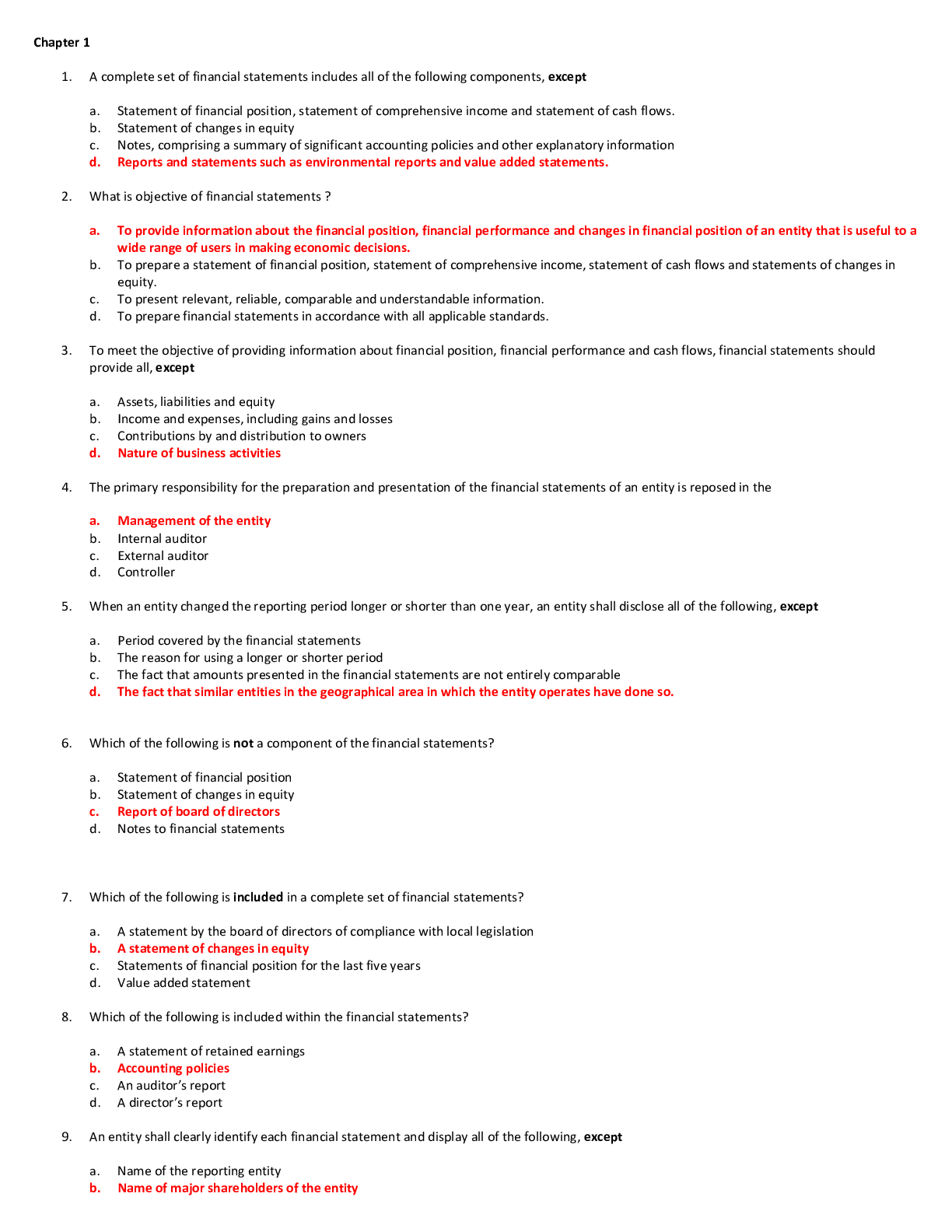
Reviews( 0 )
Document information
Connected school, study & course
About the document
Uploaded On
Feb 10, 2021
Number of pages
21
Written in
Additional information
This document has been written for:
Uploaded
Feb 10, 2021
Downloads
0
Views
397





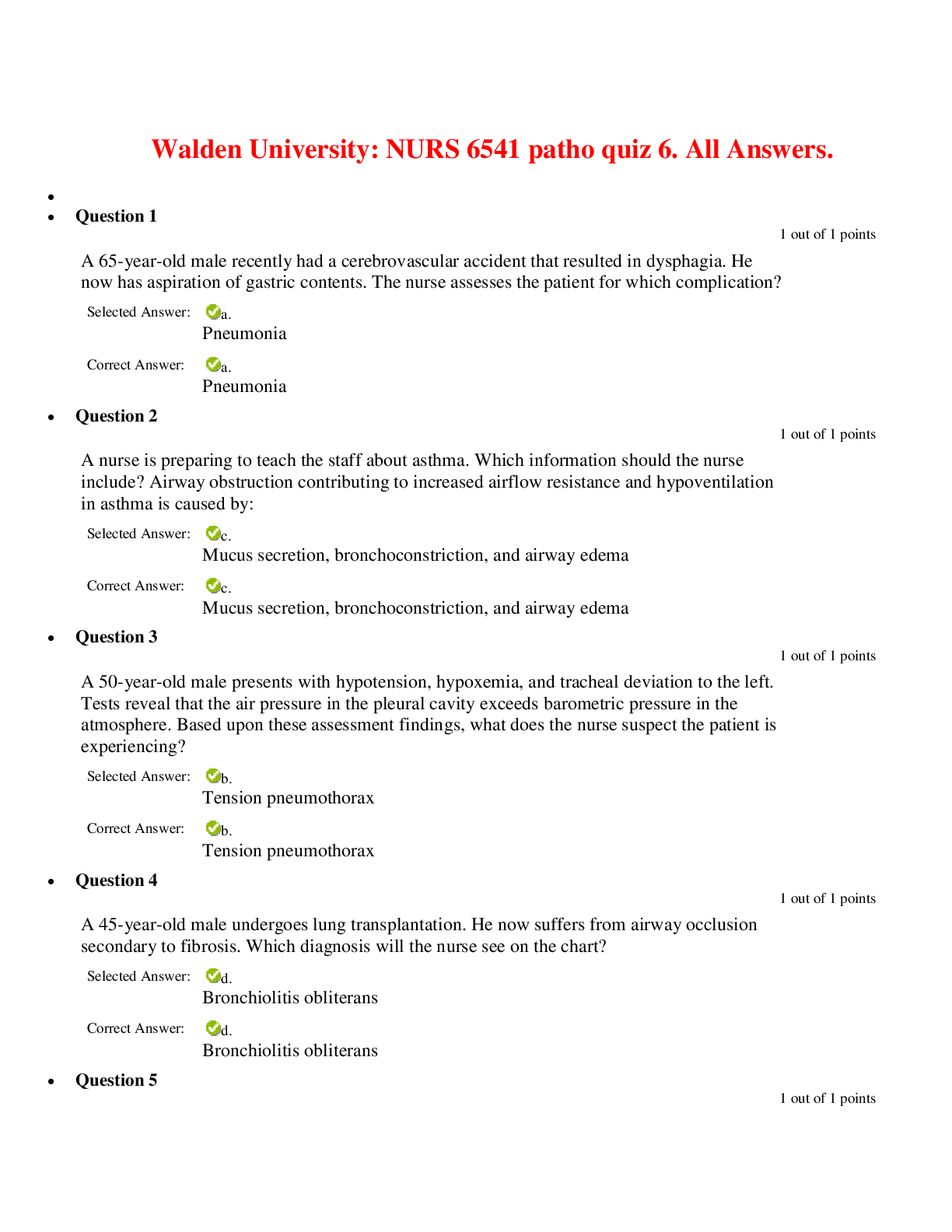





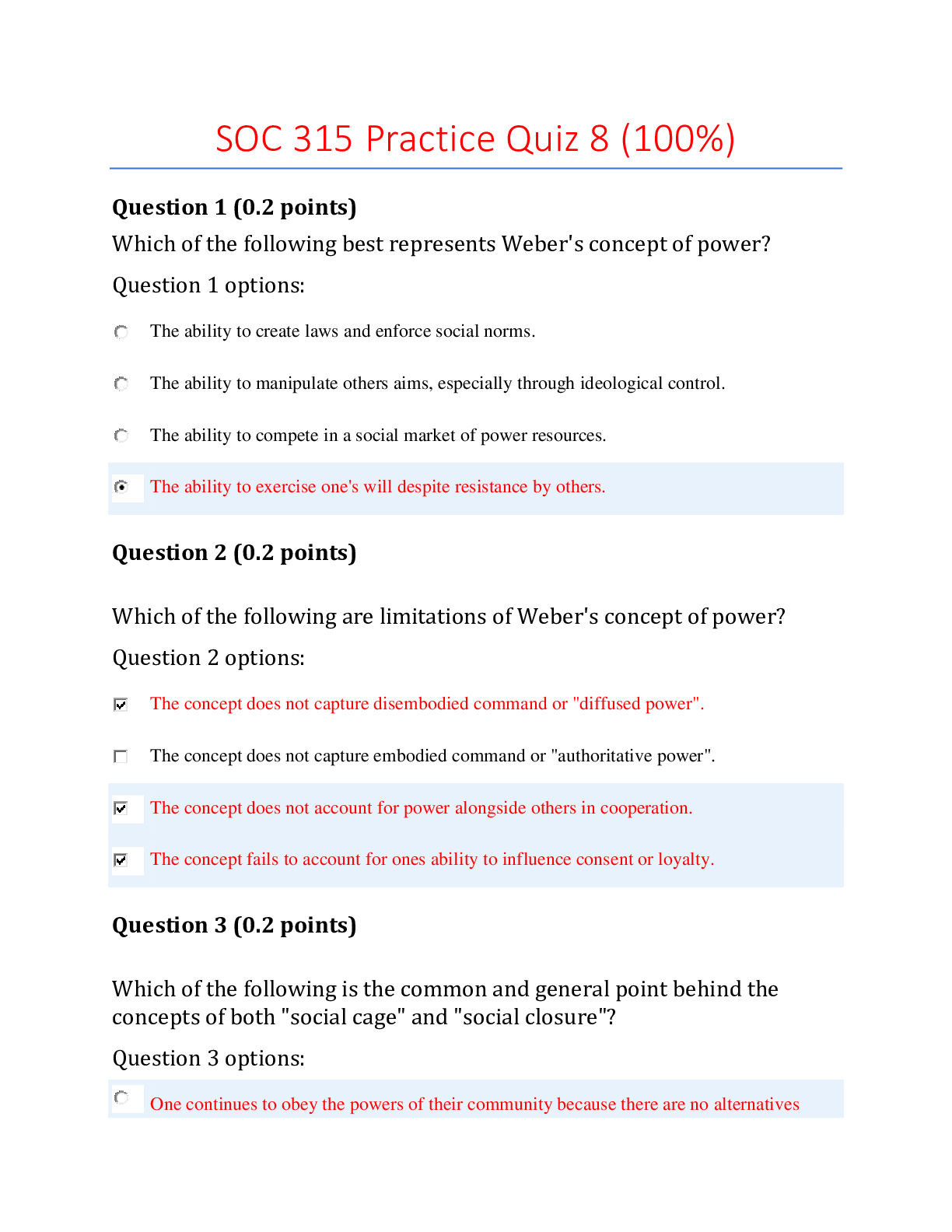
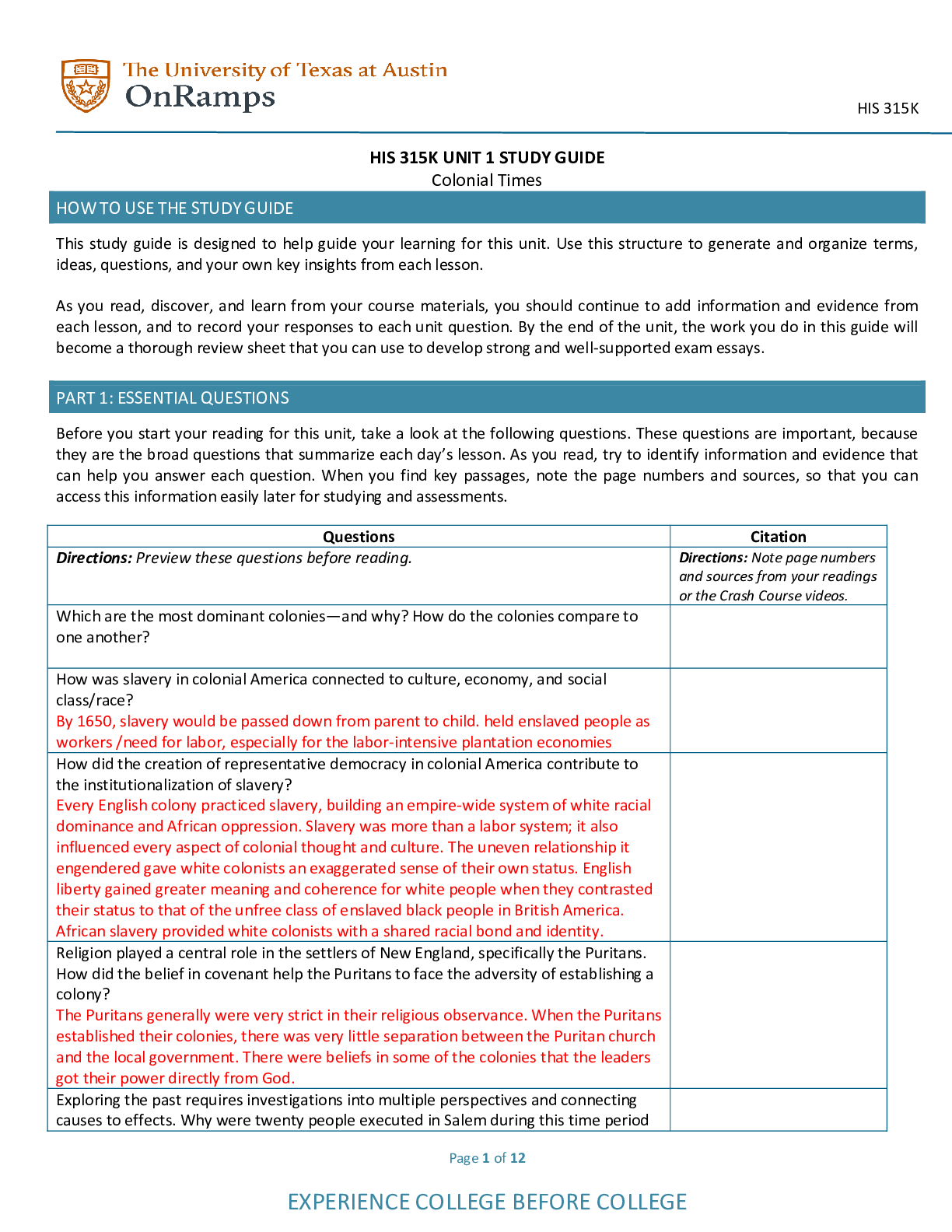
.png)

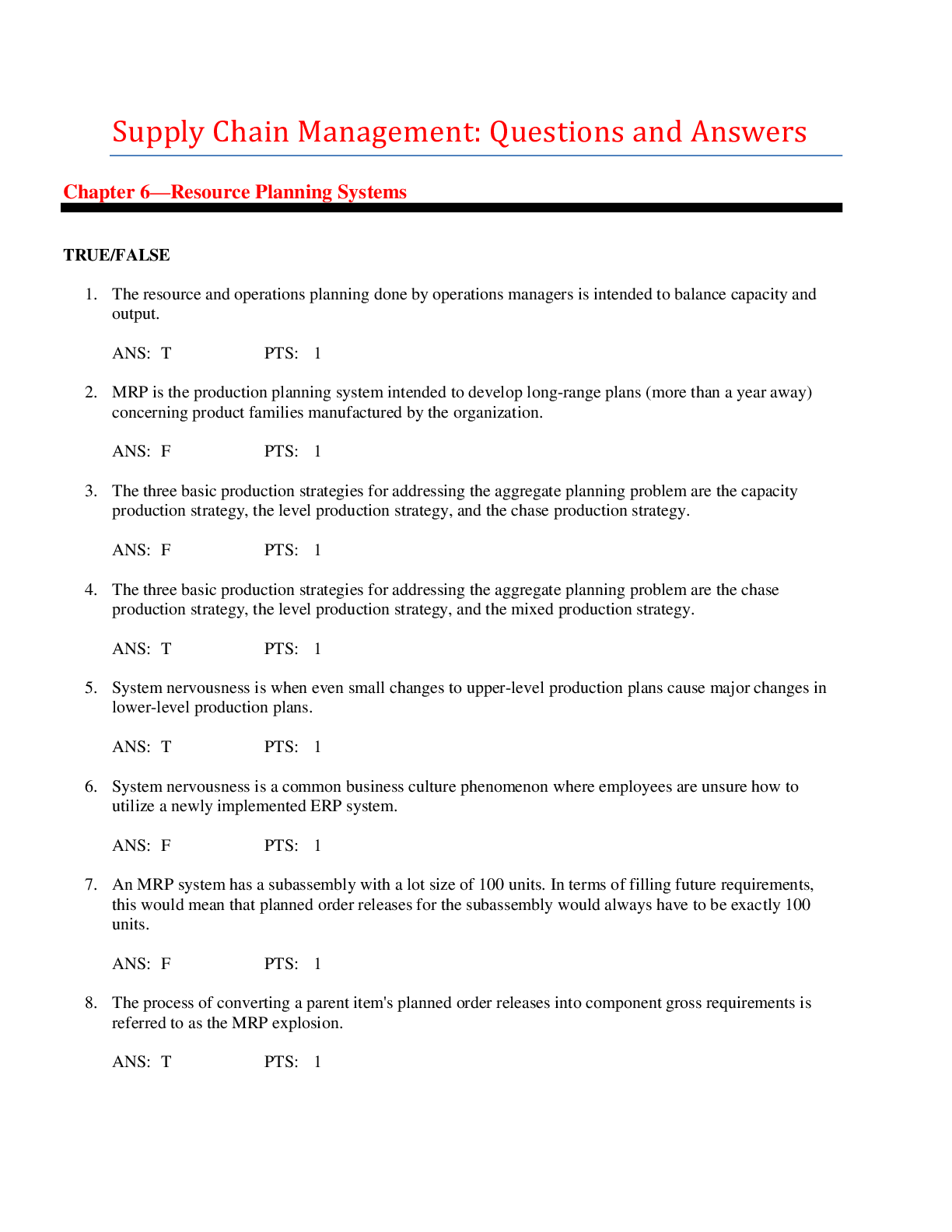
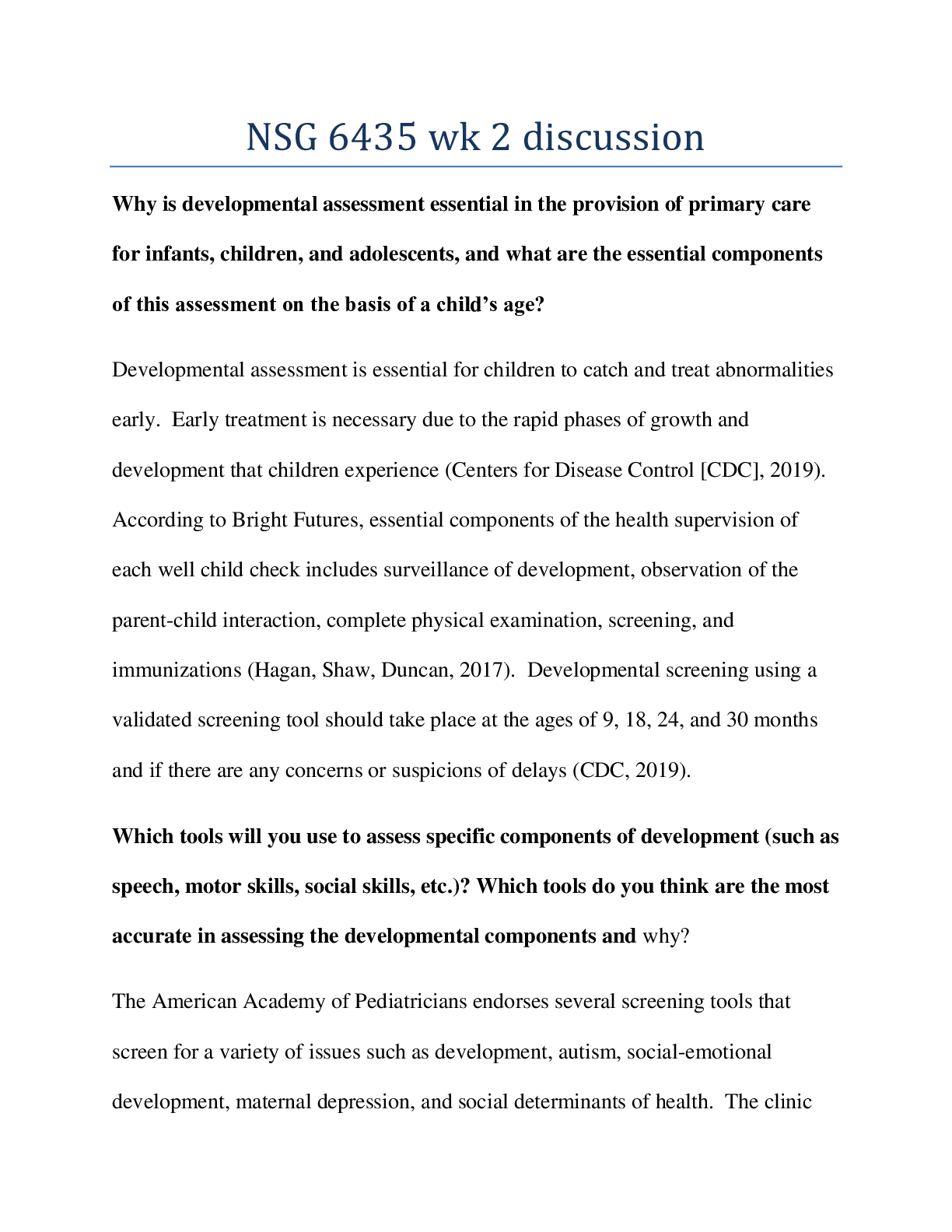
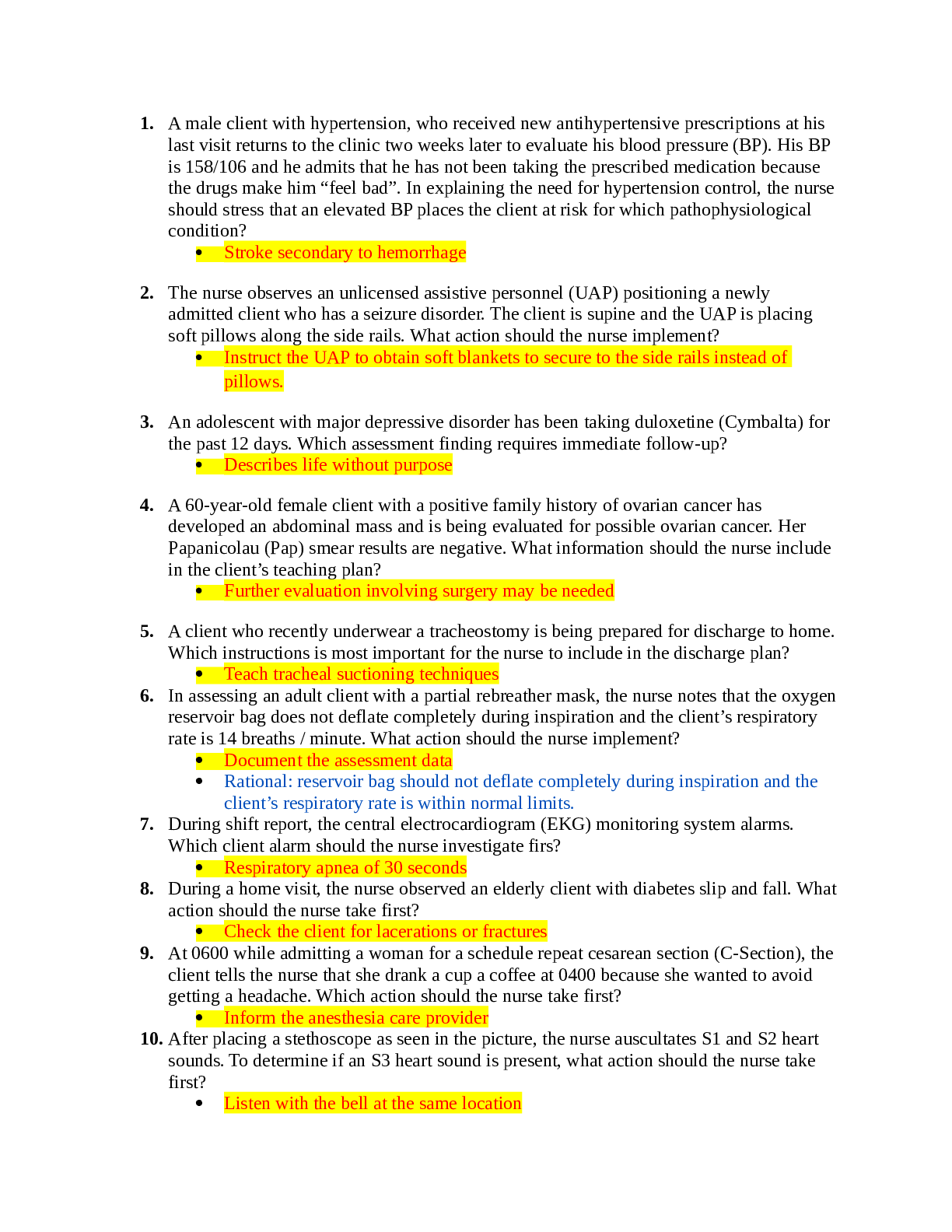

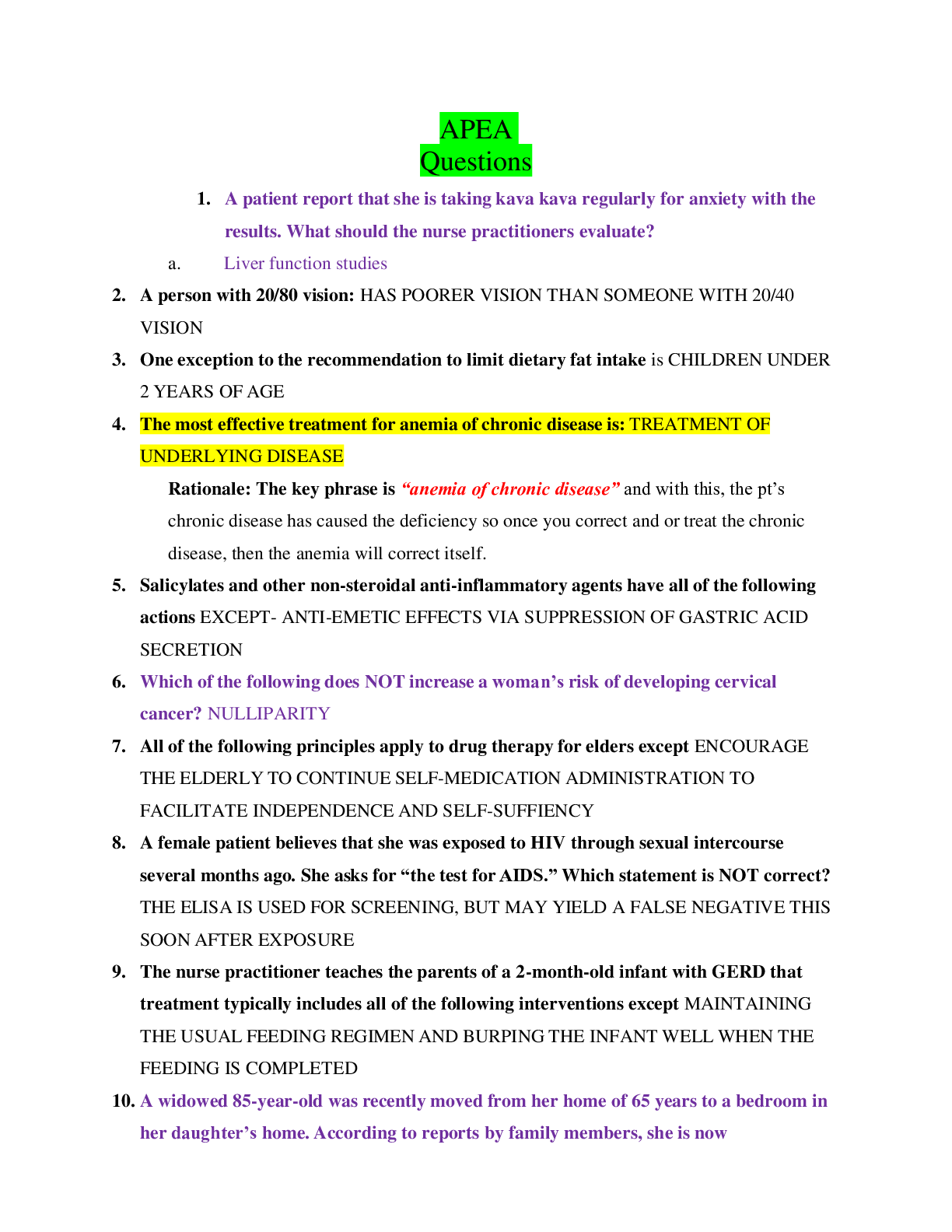




.png)

.png)

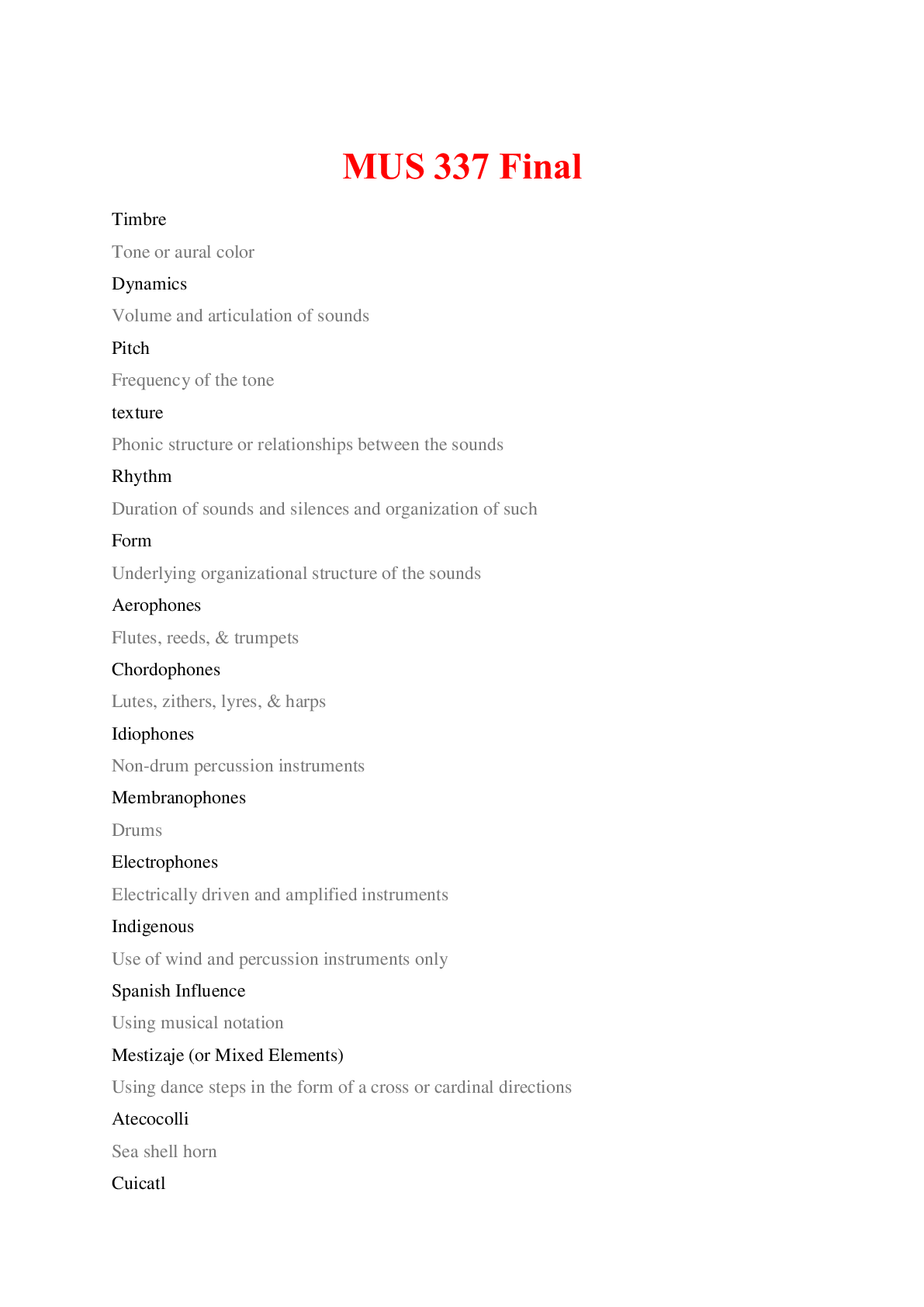

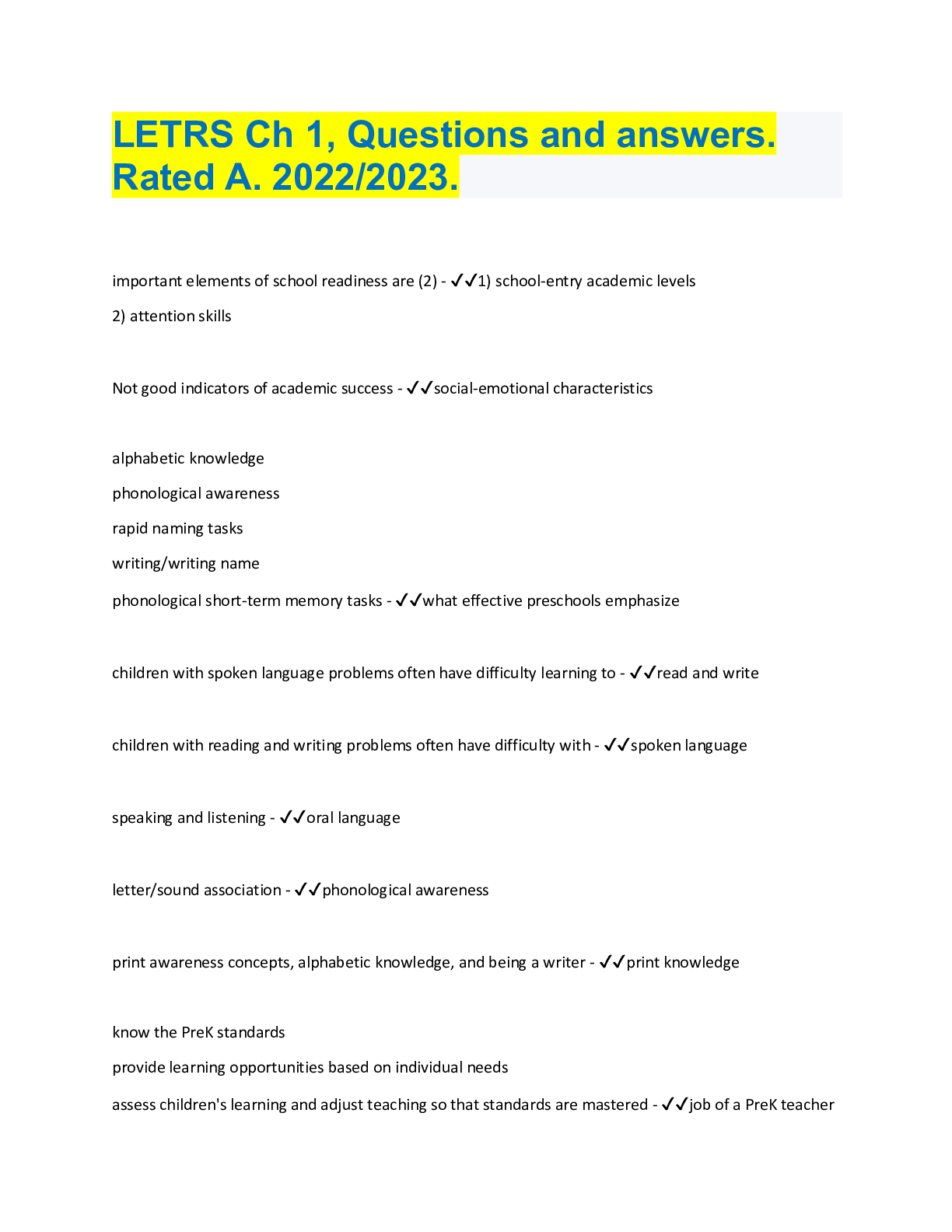
.png)
.png)

.png)
